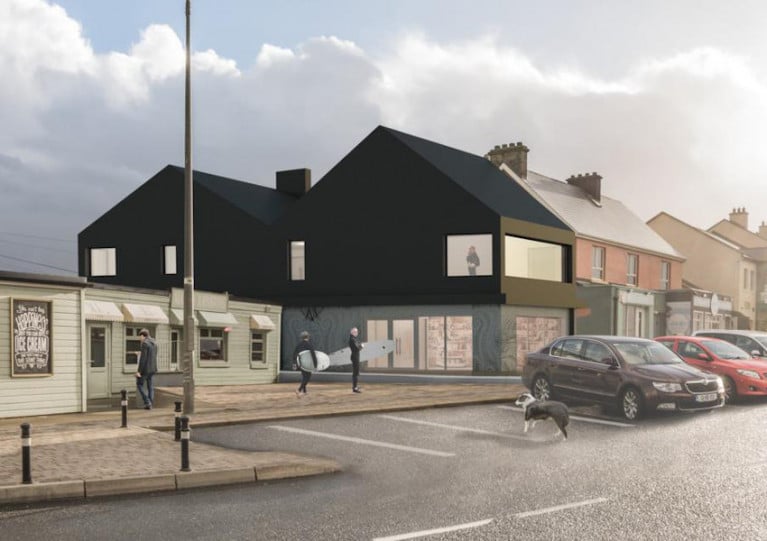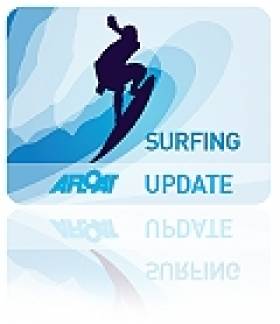Displaying items by tag: Strandhill
Strandhill Surfing Centre Gets More Funding from Fáilte Ireland
Additional funding for a long-proposed National Surf Centre of Excellence in Strandhill has been welcomed, as the Sligo Champion reports.
Fáilte Ireland has approved an additional grant of €321,468 for the project in a move hailed as positive news for the town, an important hub for Ireland’s surfing community.
Funding of over €1.6 million was announced for construction of the project in 2018 but councillors heard in October last year that costs had risen due to inflation and pandemic-related issues.
Cllr Declan Bree, chair of the Strandhill Maritime Board, said: “The new centre will be a significant facility for the people of Strandhill and the surf coast on the Wild Atlantic Way and will certainly attract increasing numbers of visitors to the region.”
The Sligo Champion has more on the story HERE.
Bold Design For New Strandhill Surfing Centre
#Surfing - A black rubber roof is one of the unusual features of the winning design for a new maritime centre in Strandhill, as the Sligo Champion reports.
The vision for the new surfing and coastal community centre by London architects Manalo & White also includes large concrete panels around the perimeter with Celtic seascapes and surfing scenes by Barry Britton, whose known as much for his art as for his waveriding legacy – not least being father of women's surfing pioneer Easkey Britton.
A planning application is expected to be completed by the end of April with a view to having the €500,000 facility, which would replace the existing centre used by the local surf club and other groups, ready in time for next year's tourism season.
The Sligo Champion has more on the story HERE.
Sligo Coastal Town's A Sweet Spot On The Wild Atlantic Way
#CoastalNotes - The Irish Independent's Kim Bielenberg recently enjoyed the hospitality of the welcoming coastal community of Strandhill in Co Sligo, where seaweed, surfing and sleeping under the stars are some of the key attractions.
Strandhill is just one of the many seaside hamlets dotted along the Wild Atlantic Way, an initiative local businesses have been swift to latch on to.
But the town's entrepreneurs have long been at one with the ocean and the rugged beauty of the coastline, from the local seaweed bath – a Sligo coast tradition – to the Kiwi-run surfing school and the beach campsite that welcomes hundreds of campers every summer.
Meanwhile, that same coastline provided the inspiration for artists Tom Phelan's seascape, which featured in a recently closed exhibition in Dublin.
Independent.ie has a sample of one of his striking and evocative surfboard paintings, with straight lines and sweeping curves that care calming and sedate, but a rough surfaces that indicates some tussles with the waves.
More of these works can be found on Tom Phelan's website HERE.
Sligo Surf Café Is A Foodie Success
#Surfing - A café-owning couple with twin passions for cooking and surfing have turned their successful business into an equally successful cookbook.
As reported on Surfers Village, Jane and Myles Lamberth were recently featured on the UTV series James Nesbitt's Ireland, which paid a visit to their eatery Shells Café in Strandhill, Co Sligo - a part of Ireland that's become a mecca for surfers the world over.
The Lamberths opened the café in 2010 and its popularity quickly led to the publication last year of The Surf Café Cookbook, featuring recipes for some of their favourite dishes from the menu.
Already a hit in world surfing hotspots from California to South Africa to Australia, its expected to get a bigger boost this summer with large orders from hip US chains.
Surfers Village has more on the story HERE.
Irish Headed to Gran Canaria for Bodyboard Worlds
#SURFING - Ireland is set to field a team of Strandhill bodyboarders at the 12th ISA World Bodyboard Championships in Gran Canaria from next week.
The event will take place in the heavy slab waves of El Frontón and la Guancha at Galdar City from 30 November to 4 December 2011.
The competition also marks the first time that bodyboard-only teams from around the world will compete in the Open Men (Prone), Open Women (Prone), Under 18 Men (Prone) and Open Drop Knee divisions.
See video of action from El Frontón in 2010 below:



























